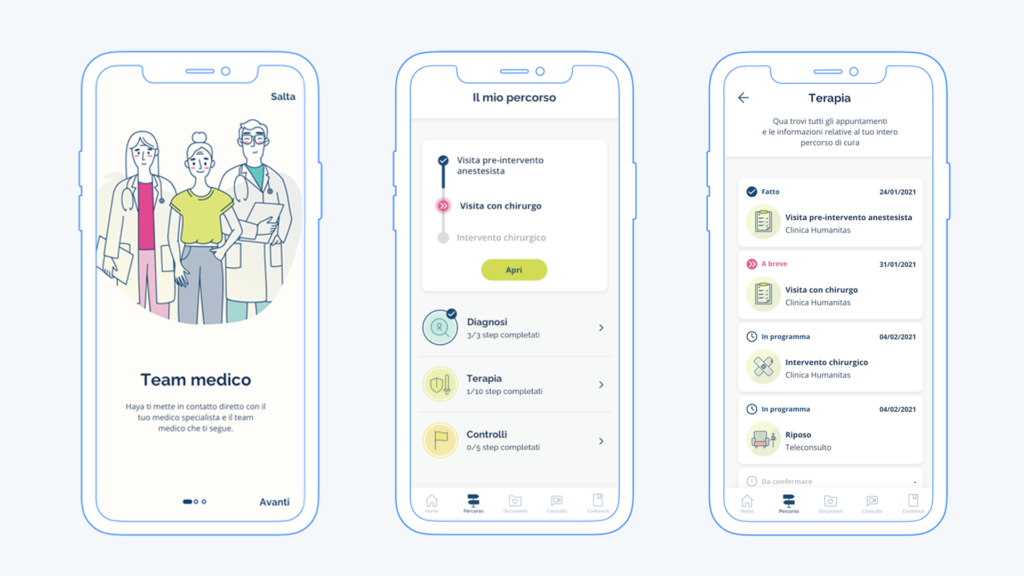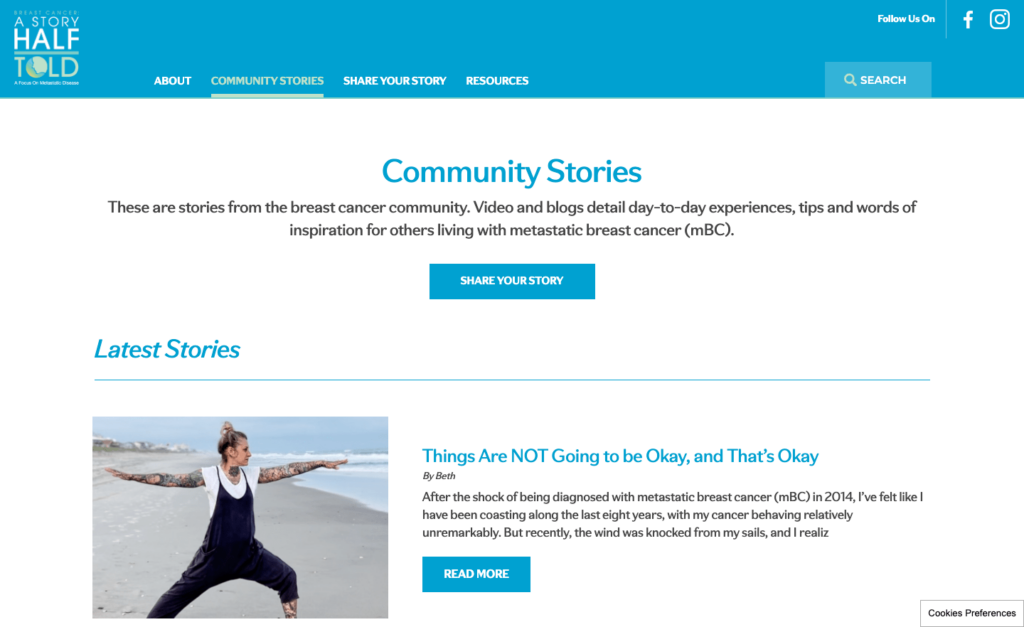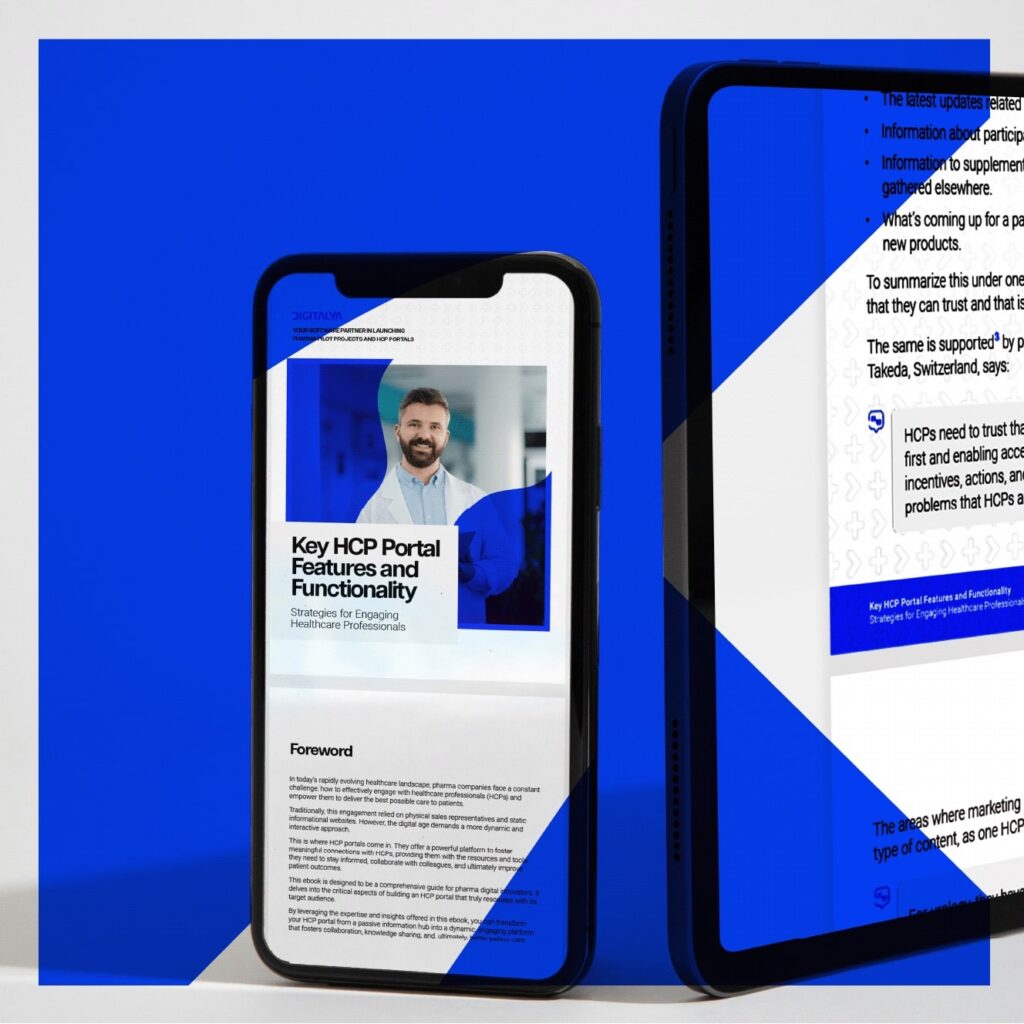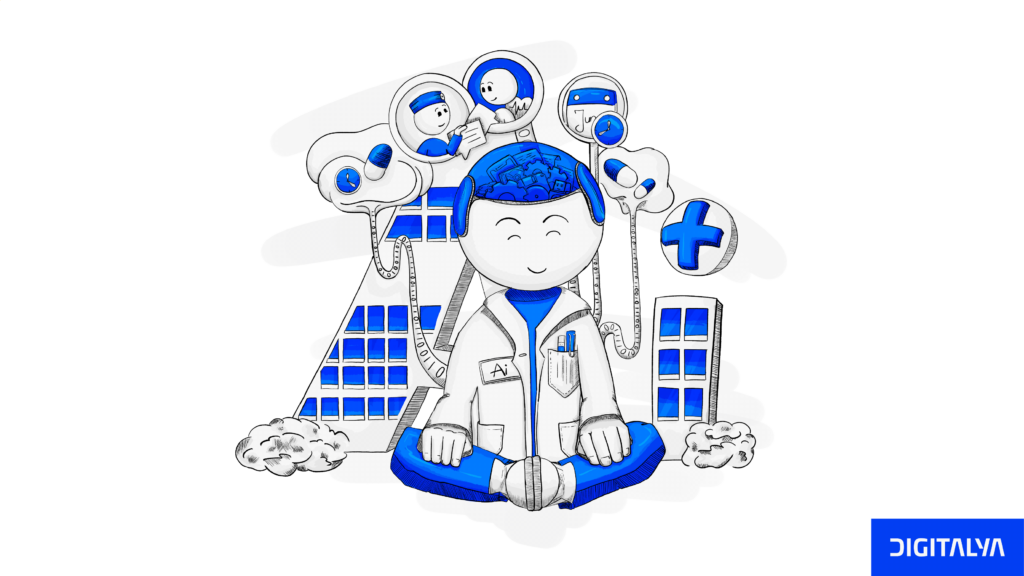The development of digital applications in healthcare plays an important role in involving individuals in managing their health and overall well-being.
The rise of digital healthcare marks a dual revolution: delivering patient care anytime, anywhere, and empowering patients to take charge of their health.
Pharma companies have a great opportunity in both of these revolutionary marks.
Data supports this claim. A recent study shows that 53% of patients rely first on their healthcare provider, followed by 47% who use pharmaceutical company websites for information.
The COVID-19 pandemic has accelerated this trend and changed the way people search for health information forever.
During the pandemic, the internet was the main source used to search for health-related information, with nearly one-third of patients increasing this habit.
Pharma companies need to step in and start capitalizing on these new patient behaviors. That’s because the continuous use of pharma-owned websites and portals depends heavily on how much providers promote their use and how easy these digital tools are to use.
Benefits for patients in using digital patient engagement strategies
By combining digital patient engagement strategies and tools, pharmaceutical companies can provide 24/7 virtual access to patients, allowing them to manage routine medical care tasks on their own schedules easily.
By actively using these tools, patients gain a deeper understanding of their condition and become empowered to self-manage their health, ultimately leading to improved health outcomes.
Other patient benefits are:
- Better understanding of their disease: by having guided access to reviewed medical advice, they can understand their symptoms, know what to expect in the future, and get a better grasp of how to manage it;
- Access to vetted and safe medical information: pharma companies can provide resources that can guide patients on safe paths, clearing any confusion found by doing mere online research and reading potentially false information;
- Community access and support: pharma companies can create safe online communities where people can find others with similar diagnoses, connect with each other, and feel a sense of community and inclusion.
Six advantages for pharma in using digital patient engagement tools
Here are the main advantages for pharma companies:
1. Enhanced medication adherence
A major challenge in healthcare is ensuring patients stick to their medication regimens.
In fact, WHO (World Health Organization) considers that “increasing the effectiveness of adherence interventions may have a far greater impact on the health of the population than any improvement in specific medical treatments.”
WHO also states that 50% of chronic illness patients are not taking medications as prescribed.
One reason for poor medication adherence is a lack of information. In fact, patients want to discuss their concerns about medications. Better communication and information appear to be among the most crucial factors for patients’ medication adherence.
That lack of access to quality information leads to 25,000 preventable deaths and $100 billion to 300 billion in preventable medical costs, according to the US Center for Disease Control and Prevention.
Digital engagement tools can make a difference, and studies show that electronic reminders and maintaining ongoing communication are among the key contributors to increasing medication adherence.
2. Streamlined clinical trials
Despite their importance, clinical trials face challenges like recruiting and retaining participants, ensuring diverse representation, and managing data.
Difficulties finding eligible people and keeping them involved stem from factors like location, lack of awareness, and limited candidate pools.
Virtual trials that leverage remote patient participation and virtual visits can address these issues.
By removing geographical barriers, virtual trials reach a wider range of potential participants.
Digital tools can help by facilitating online recruitment, offering remote patient monitoring capabilities, and improving participant communication. This leads to faster trial completion, better risk assessments, and potentially quicker introduction of new drugs to the market.
3. Valuable patient insights
Digital tools allow for real-time data collection from patients. This data can be anonymized and analyzed to gain valuable insights into patient experiences, treatment effectiveness, and potential side effects.
This knowledge can be used to improve existing medications, develop targeted therapies, and inform future research efforts.
4. Building patient loyalty
Digital tools can foster a sense of community and support for patients.
By providing patients with educational content, facilitating communication with healthcare professionals, and offering peer-to-peer connections, pharma companies can build stronger patient relationships, leading to increased brand loyalty.
5. Targeted communication
Digital tools allow for personalized patient communications.
Companies can tailor educational materials, medication reminders, and support programs to individual needs and preferences. This targeted approach is more effective than traditional mass marketing and fosters a better patient experience.
6. Improved market differentiation
In today’s competitive market, pharma companies need to stand out. By embracing digital patient engagement tools, companies demonstrate a commitment to patient-centric care and innovation.
This can be a crucial differentiator when attracting patients and healthcare professionals alike.
The rise of the empowered patient
Patients’ access to health information has gone through a revolution. In the past, patients received information from brochures and doctor visits.
Now, the internet and mobile devices provide a wealth of resources, including patient-generated content and personalized health portals designed to improve patient engagement. This shift allows for more proactive care and information exchange between patients and doctors.
Patients express a greater need for self-management information than other forms of information.
Most importantly, there is a need for basic, straightforward information.
Although factors such as the information explosion, increased health ownership, and technological advancements have been key to increasing patient empowerment, you need to pay attention to patients’ different information needs if you want to close gaps in care.
Some need basic details about chronic diseases or treatment, while others want in-depth comparisons and treatment options.
Tailoring information to individual needs, including preferred sources and situations, is crucial for effective communication and patient understanding.
That’s why there is an increased need to use various digital patient engagement tools and strategies tailored to patients’ needs.
Key digital patient engagement tools pharma can leverage
Now that we understand the advantages for pharma companies in engaging directly with patients and the ways patients expect these interactions to go, let’s dive into a few digital patient engagement tools perfect for the job.
1. Patient portals
Healthcare companies often use patient portals to maintain direct communication with patients and provide easy access to their health data, such as lab results, appointment scheduling, etc.
This direct line of communication and interaction with the patient is what pharma companies can duplicate when creating their own patient portals.
Here are a few ways you can use patient portals to increase patient engagement with your pharma brand:
Offer disease educational resources
Populate patient portals with educational materials, patient engagement resources, and information about your products, health conditions, and treatment options (aka patient education platform).
By offering valuable content, you can position your pharma brand as a trusted source of information, driving patients’ engagement and brand loyalty to new heights.
Add detailed explanation about how your medication works
Medication costs and doubts often derail chronic illness treatment despite reminders. Patient portals with clear info on how meds work and their long-term benefits can improve trust and adherence.
Include a doctor directory feature
Allow patients to find appropriate care easily. Nearly 90% of patients express a desire for physician directories and doctor rating features on pharmaceutical websites, highlighting the difficulty of finding and evaluating qualified providers.
Offer medication management tools
Studies show that patients use these tools and are excited about developments in this area. Include features such as medication reminders, refill alerts, and symptom tracking, which can enhance the overall patient experience and improve medication adherence.
Add communication and support features
The patient portal can be a link between patients and HCPs by having a two-way digital communication feature for questions and concerns, contributing to the closing of the care gap.
Plus, you can add telehealth integration for virtual consultations and for communicating with their providers. Plus, you can offer support groups that can allow patients to use straightforward online scheduling tools to connect, share experiences, and offer peer-to-peer support. All of these lead to improved care.
Use gamification to increase medication adherence and engagement
Studies reveal that gamification, incorporating elements like rewards, badges, and progress tracking, can significantly boost patient engagement.
Imagine offering points for completing educational modules, badges for consistent medication adherence, or a leaderboard for active community forum participants.
This playful approach motivates patients to interact with the content and fosters a sense of achievement, ultimately leading to better health literacy and medication adherence.
Teva Pharmaceuticals uses patient portals to support patients who are managing their disease with their medication.

People suffering from migraines, asthma, multiple sclerosis, cancer, or iron overload can find dedicated portals with additional resources, support, and knowledge.
Using the portals requires patients to enter specific codes found on their medication boxes, which limits outside access for people who are not treated with Teva’s products. With these portals, patients can be active participants in their care delivery.
2. Digital companion apps
Companion apps empower patients by putting their healthcare management at their fingertips.
They keep patients engaged and in control of their condition and allow them to stay comfortably at home, reducing the need for frequent healthcare facility visits – a win-win for providers and patients.
These tech-powered apps also bridge the gap by boosting patient engagement and medication adherence by becoming part of their care plan. Their user-friendly design empowers patients and healthcare providers (HCPs) to take an active role in managing chronic conditions and overall health.
This generates a great opportunity for pharma companies to create digital companion apps that complement their medication and help patients monitor their health and progress.
These companions can also help reduce costs for patients and health centers (via virtual care, controlled health monitoring, and integration with electronic health records) and lower health risks.
In the short term, pharma companies can also use them to introduce patients to new treatments, enable care coordination for HPCs, and guarantee their adherence and compliance with prescribed regimens.
The generated real-world data (RWD) allows for robust data collection, leading to deeper, actionable insights on how and why patients follow or quit treatments.
In the long term, improving patient health outcomes and allowing for better care translates into higher revenue. Take, for example, a blockbuster drug generating $10 billion annually. Extending the patent lifespan by two years translates to an additional $30 – $50 billion in revenue.
A great example of a digital companion app is the HAYA app from AstraZeneca.

It’s one of the first collaborative and integrated AI-assisted screening apps. It features a suite of advanced and user-friendly deep Learning-based services, simplifying the detection of health issues.
The integrated analysis models categorize and correlate individual biometric and psychological data, ensuring care teams are always informed about their patient’s health status.
Haya also enables physicians to adjust their patients’ care journeys, providing real-time updates on any changes.
Other big pharma companies are also making moves. Roche partnered with digital health software developer Temedica to help multiple sclerosis patients manage their condition using a digital companion mobile app.
The app aims to collect daily health data like activity, sleep, and dietary habits and give patients a place to track their MS symptoms.
The digital companion app named Brisa analyzes the information provided and pinpoints potential areas for improvement.
It also suggests lifestyle changes that might help patients manage their condition in tandem with their existing medication and treatment plans, helping deliver high-quality care.

3. Patient online course platforms
Digital platforms that offer patients and caregivers educational courses, resources, and information are gaining traction and delivering real results.
These tools go beyond traditional medication information.
Imagine a quiz that assesses the chronic pain condition, followed by a personalized course offering educational modules, exercise tips, and support resources – all tailored to the patient’s specific needs.
This interactive approach empowers patients, fosters a sense of control over their health, and builds stronger relationships with the companies developing treatments.
A great example is Pfizer’s “Selfapys Online Course for Chronic Pain” app. The reimbursable 12-week online course uses video, text, and audio content to help patients with back pain and chronic pain management with psychological and somatic components.
The app delivered a 26% reduction in pain intensity and a 20% increase in quality of life.

Another example is GSK. The company created a quiz app to validate innovation opportunities. In just a few days, the Shine Quiz app collected thousands of answers from women looking for help with hormone-related health issues.

4. Discussion forum and online communities
While user-generated content (UGC) and interactive client engagement are driving forces in many industries, pharma companies are more cautious.
The highly regulated and sensitive nature of their products necessitates a different approach that prioritizes accuracy and control over unfettered online interaction.
Pharma might be missing out on a huge opportunity, given that patients, especially after COVID-19, use the Internet as a source of information about their diagnosis.
That’s also where people find comfort in connecting with others with the same struggles.
Studies indicate that online communities support patient empowerment as a process and as outcomes of these processes.
There are four core principles for creating a thriving patient community:
- Put active listening and educational discussions at the heart of the community.
- Encourage community contributions because these platforms’ appeal, energy, and influence seem to depend strongly on these central members’ contributions and activities.
- Provide reference elements to help identify the members if you want to generate collective empowerment and establish a relational approach to building loyalty among these active contributors. Identification does not mean access to personal information.
- Ensure data safety to encourage active participation: privacy concerns harm users’ willingness to share information on community platforms. That’s why it’s imperative to make all efforts to desensitize the information shared by users while providing effective information support to clarify how their data is being processed, stored, and kept safe.
Pfizer’s Breast Cancer: A Story Half Told is an excellent community example. They created a social media page and website to document people’s stories and encourage others to contribute to the community with their own voices.

Creating a digital community platform for patient engagement should be key to delivering pharma messages.
5. Gamification tools and apps
There’s a big industry around healthcare gamification, with a market size of about USD 25.3 Billion in 2020 and a predicted growth of 14.6% from 2021 to 2027.
It’s clear that harboring our innate drive to achieve, advance, and receive recognition for our endeavors is useful.
Although gamification engagement solutions can’t cure patients, they can motivate them in health management by adhering to healthy lifestyle practices and overcoming challenging health tasks, which results in improved patient outcomes.
Pharma companies can leverage gamification elements such as reward systems, trackers, gamified challenges, progress bars, rewards and badges, and virtual competitions to increase patient engagement and medication adherence.
Gamification elements can be added to existing digital patient engagement tools to engage patients (e.g., in Patient Portals), but can also be standalone apps or tools.
Either way, here are some gamification strategies you can employ:
- Simulating a game: the strategy uses visual elements to emphasize the importance of adhering to a certain lifestyle or treatment, visualize the adverse effects and consequences of health-related issues;
- Incorporating storytelling: educate patients by creating a story around the tasks or activities you expect from patients, as people connect better when they can identify with certain characters or storylines;
- Checkpoints and challenges: these can help keep patients consistent with the proposed activity (e.g., taking their medication on time). Getting the feeling that you hit milestones gives a sense of accomplishment;
- Progress bars: using this type of graphic elements to help people move forward with their treatment plan allows for better medication adherence and adds a real sense of progress;
- Ratings and leaderboards: this feeds into our need to compare with others and our competitive nature, which can be a great motivator and can help in improving patient satisfaction;
- Rewards and badges: this approach encourages patients to set milestones for accomplishing healthcare goals that had previously seemed tedious or challenging. Winning rewards instill a sense of pride and motivate them to keep up their good work.
Conclusion
The healthcare landscape is undergoing a digital revolution, and pharmaceutical companies that embrace the shift towards patient activation will be best positioned to thrive.
By implementing a comprehensive digital patient engagement strategy that incorporates elements like informative patient portals, gamified learning experiences, health risk assessment apps, and online support communities, pharma companies can not only empower patients to take an active role in their health but also foster patient trust, improve medication adherence, and ultimately achieve greater success.
As we move towards a more patient-centric healthcare model, prioritizing digital engagement strategies is no longer an option but a necessity for the future of pharma.






